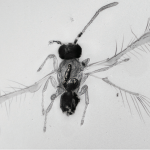fly
A still shot from the 3D-IsoView microscope shows neural activity within a Drosophila larva detected with fluorescent indicators. Image courtesy of Keller Lab, HHMI/Janelia Research Campus
A new kind of three-dimensional technology, called IsoView, allows researchers to view biological processes within nontransparent animals that are rather large by microscopy standards such as the drosophila larva above and even the brains of larval zebrafish. According to the article in Nature Methods, the new type of microscope developed at the Janelia Research Campus (Ashburn…
Dr. Vivek Jayaraman and colleagues at the Howard Hughes Medical Institute Janelia Research Campus discovered that the ellipsoid body located in the middle of a fly's brain acts like a compass to help navigate flight even in darkness. By placing the flies into a small virtual reality arena and having the flies walk on a rotating ball, they could study the activity of neurons within the ellipsoid body while the animal was moving.
These videos show how the fly experiment was done:
Check out the news release for more information about this neat study.
I have heard of some animals using sugars as antifreeze (check out the prior blog on wood frogs that freeze and survive!), but never lipids.
Image from http://thebuggeek.com/tag/eurosta-solidaginis/
Researchers have discovered that larva of the Goldenrod gall fly (Eurosta solidaginis) shown above survive nearly freezing solid as well, which they hypothesize may be accomplished by accumulating acetylated triacylglycerol, or agTAGs, (i.e. a type of lipid) during winter. They found that the flies accumulate this lipid from September through March and studies of the agTAGs show that this…
Artist's rendition of dendrite regeneration in a fruit fly during metamorphosis. (Chay Kuo Lab, Duke University)
Researchers at Duke University are interested in understanding the metamorphosis of fruit flies from larvae to adult stage in an effort to understand how the insects grow new nerve endings as they undergo this transition. What is interesting is that the flies lose neurons they will not need as an adult and will grow new nerve endings. According to a press release from Duke University, a protein called Cysteine proteinase-1 (Cp1) is important in the regeneration step. In fact,…
I just read this blog describing the very strange animal moments. Check it out!
http://blogs.scientificamerican.com/running-ponies/2013/12/24/top-ten-s…
Just look at the cute little Tinkerbella fly, a mere 250 micrometers long, that was discovered in Costa Rica:
Imageof Tinkerbella from Scientific American.
In honor of our most beloved Thanksgiving dinner guest:
Despite their rather large stature, ranging from 2.5-10.8 kg, wild turkeys (Meleagris gallopavo) can fly as seen in this video:
For more information about turkeys:
Cornell Lab of Ornithology
Image of creme brulee by Moniza, from www.allrecipes.com
Researchers at the University of Washington have shown that a trace component in burnt sugar (like the creme brulee above) and Caramel Colour III (used to color dark beers, brown sugar, etc) has been shown to help regenerate muscles in both fruit fly and mouse models of Duchenne muscular dystrophy.
Drs. Morayma Reyes (Professor of Pathology and Laboratory Medicine) and Hannele Ruohola-Baker (Professor of Biochemistry; Associate Director of the Institute for Stem Cell and Regenerative Medicine) studied mouse models that…
A fly landing in the ear of a tourist visiting Peru turns out to be more than just annoying. The screwworm fly had sufficient time to lay eggs that hatched flesh-eating maggots in her ear canal.
Warning: the video may be disturbing to some viewers
As strange as this sounds, it is not that uncommon
Fortunately the screwworm fly has been effectively eradicated in the United States since the 1960's by releasing sterile male flies resulting in fewer and fewer offspring. This work was conducted by the USDA as you can imagine how this fly would decimate livestock.
Here's a snippet of some of the relevant text from the article describing the model below:
show attribute/state-oriented functions.
Type7. [Useful Attribute/State]: 2.3) Change of structure or object
directly make a useful "attribute" including "ability".
Type8. [Attribute/State]à Interactionà [Useful State]: 2.4) Change of
structure or object makes interaction between its "attribute/state" and the
other "attribute/state" which makes up a useful "state".
show
And now for the actual model:
Any guesses? Head past the break for the big reveal. Trust me - you'll be surprised.
Got it…
If you looked at the penis of a Drosophila fly under a microscope (for reasons best known only to yourself), you'd see an array of wince-inducing hooks and spines. These spines are present in all Drosophila and they're so varied that a trained biologist could use them to identify the species of the owner.
What's the purpose of these spines? Are they intended to actually wound the female during mating? Do they help the male fly to scrape out the sperm of his rivals? Do they actually pierce the walls of the female's genital tract, allowing the male to bypass any barriers to his sperm, as…
Some incredible early morning shots of wet insects by German photographer Martin Amm.
Red veined darter
Horsefly
more below the fold
Emerald damselfly
Breakfast
Check out more of his work here





